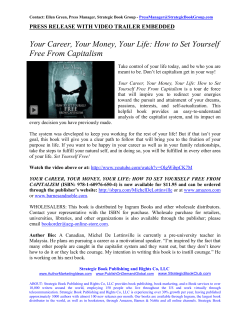
Evolution of marketing Marketing Evolution
Evolution of marketing Marketing Evolution Business orientation References Marketing 'Marketing' is the craft of linking the producers (or potential producers) of a product or service with customers, both existing and potential. It is an inevitable and necessary consequence of capitalism. Marketing However marketing is not limited to capitalist countries. Marketing techniques are applied in all political systems, and in many aspects of life. Marketing methods are informed by many of the social sciences, particularly psychology, sociology, and economics. Marketing Marketing research underpins these activities. Through , it is also related to many of the creative arts. What marketing involves Contrary to the popular conception, marketing is not just about promotion -it can be divided into four sections, often called the "four Ps". Four Ps They are: Product - The Product management aspect of marketing deals with the specifications of the actual good or service, and how it relates to the end-user's needs and wants. Pricing - This refers to the process of setting a price for a product, including discounts. Four Ps Promotion - This includes , publicity, word of mouth, and personal selling, and refers to the various methods of promoting the product, brand, or company. Place or distribution refers to how the product gets to the customer; for example, point of sale placement or retailing. Four Ps These four elements are often referred to as the marketing mix. A marketer will use these variables to craft a marketing plan. For a marketing plan to be successful, the mix of the four "p's" must reflect the wants and desires of the consumers in the target market. Four Ps Trying to convince a market segment to buy something they don't want is extremely expensive and seldom successful. Marketers depend on marketing research to determine what consumers want and what they are willing to pay for. Four Ps Marketers hope that this process will give them a sustainable competitive advantage. Marketing management is the practical application of this process. Evolution of marketing Marketing as we know it today began in the 1970's with the birth of the "marketing orientation". During the first stage of capitalism business had a production orientation. Evolution of marketing Business was concerned with production, manufacturing, and efficiency issues. By the mid 1950's a second stage emerged, the sales orientation stage. Evolution of marketing Business's prime concern was to sell what it produced. By the early 1970's a third stage, the marketing orientation stage emerged as businesses came to realize that consumer needs and wants drove the whole process. Evolution of marketing Marketing research became important. Businesses realized it was futile putting a lot of production and sales effort into products that people did not want. Some commentators claim that we are now on the verge of a fourth stage, one of a personal marketing orientation. Evolution of marketing They believe that the technology is available today to market to people on an individual basis (see personalized marketing, permission marketing, and mass customization). Evolution of marketing They feel it is no longer necessary to think in broad aggregated terms like market segments or target markets. Evolution of marketing Marketing has become an academic discipline in itself, with tertiary degrees in the field now routinely awarded. Evolution of marketing Masters and Doctrinal degrees can be obtained in numerous subcategories of marketing including: Marketing Research, Consumer Behaviour, International Marketing, Industrial Marketing (also called b-to-b marketing), Consumer Marketing (also called b-to-c marketing), Product Management, and e-Marketing. Marketing orientation A marketing oriented firm is one that allows the wants and needs of customers and potential customers to drive all the firm's strategic decisions. Marketing orientation The firm's corporate culture is systematically committed to creating customer value. In order to determine customer wants, the company usually needs to conduct marketing research. Marketing orientation The marketer expects that this process, if done correctly, will provide the company with a sustainable competitive advantage. Marketing orientation A marketing oriented firm will typically show the following characteristics: extensive use of marketing research broad product lines emphasis on a product's benefits to customers rather than on product attributes Marketing orientation use of product innovation techniques the offering of ancillory services like credit availability, delivery, installation, and warranty Marketing orientation The concept of marketing orientation was developed in the late 1960's and early 1970's at Harvard University and at a handfull of foward thinking companies. Marketing orientation It relaced the previous sales orientation that was prevalent between the mid 1950's and the early 1970's, and the production orientation that predominated prior to the mid 1950's. Marketing Management Marketing management is the practical application of marketing techniques. It is the analysis, planning, implementation, and control of programs designed to create, build, and maintain mutually beneficial exchanges with target markets. Marketing Management The marketing manager has the task of influencing the level, timing, and composition of demand in way that will achieve organizational objectives. Marketing Management Involves Understanding the economic structure of your industry Identify segments within your market Identifying your target market Do marketing research to develop profiles (demographic, psychographic, and behavioural) of your core customers Marketing Management Involves Understand your competitors and their products Develop new products Establish environmental scanning mechanisms to detect opportunities and threats Understand your company's strengths and weaknesses Marketing Management Involves Audit your customers' experience of your brand in full Develop marketing strategies for each of your products using the marketing mix variables of price, product, distribution, and promotion Create a sustainable competitive advantage Marketing Management Involves Understand where you want your brands to be in the future, and write marketing plans on a regular basis to help you get there Setup feedback systems to help you monitor and adjust the process References This Presentation is based on Fact Index Adaptation by Finntrack
© Copyright 2025





















